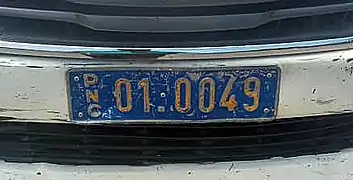Vehicle registration plates of the Democratic Republic of the Congo
The issuing of the current license plates of the DRC began in April 2009. The plates are based on the layout of the registration plates of the European Union, but are of a slightly different in size (480 × 112 mm) than the European standard size (520 × 110 mm). At the left side is the national flag of the DRC which is displayed with the letters "CGO" below. The serial combination consists of five numbers followed. In addition, located on the front windshield of the vehicle, a so-called third mark in the form of an 84 × 53 mm large sticker. It repeats the serial combination on the plate and it also includes the chassis number of the vehicle.[1]
.jpg.webp)
The DRC plates are produced by Utsch. [2][3] The plates have various security features to make counterfeiting difficult.[4] For example, the background of all letters has a hologram foil labeled authentic. Similar measures are also found in the plates produced by Utsch for the licenses of Egypt and Kyrgyzstan.
Special plates
.jpg.webp)
- Plate diplomatic red on yellow, 3 digits corresponding to a country code, the CD symbol, 2 or 3 digits
- Plate consular corps: red on yellow, 3 digits corresponding to a country code, the CC logo, 2 or 3 digits
- Plate of the FARDC: white on black, FARDC followed by 7 digits
- Plaque from the United Nations, MONUC: black and white, the symbol A, 3 or 4 digits
- Plate EUSEC: yellow to dark blue, EUSEC abbreviation followed by 3 figures
- Plate EUPOL yellow to dark blue, EUPOL abbreviation followed by 3 figures
- Temporary registration plate: white on dark blue, 3 figures, the IT acronym, 3 figures
- Plate authorities:
Presidential **: black and white, the PR initials followed by 3 or 4 digits
- National Assembly: black and white, the AA acronym followed by 3 figures
- Senate: black and white, the symbol ASEN followed by 3 figures
- Justice: black and white, the ADJ abbreviation followed by 3 figures
.jpg.webp) Plate diplomatic
Plate diplomatic Plate of the FARDC
Plate of the FARDC
 Police
Police
Previous plates

Older style license plates have different letter and background colors depending upon the era when the plate was issued. Each plate carried the initials of the province where the car was registered, but sometimes the abbreviation of another province would be issued.
- Yellow numbers on Blue background (1958 - 1960), Belgian Congo
- Yellow numbers on Blue background (1960 - 1979), DRC/Zaire, but no change from Belgian Congo style
- Yellow numbers on Green background (1979 - 1997), Zaire
- Black numbers on yellow background (1997)
- Yellow numbers on blue background (1980 - 2009)
The style of the Belgian Congo plates, yellow numbers on a blue background, was continued by the DRC/Zaire until 1979. Plates started with a yellow star, followed by one or two letters with a maximum of four digits after the letter.
In 1979 the plate colors were changed to yellow numbers on a green background. At the beginning were now two provincial letters followed by four digits and a further letter.
In 1997 the plates were redesigned to show a two letter province code, followed by four numbers, and a two letter suffix. These plates had black numbers on a yellow background (430 × 105 mm).[5]
With the change of the country's name back to the DRC in 1979, the license plates returned to the traditional colors of yellow numbers on a blue background. The first two letters of the plate indicated the Province followed by a star, then four digits, and finally two letters. These plates were used until the introduction of the current system in 2009.
Province codes
| Province | Code | Code (1996)[6] |
Code (1980) |
|---|---|---|---|
| Bandundu | BN | BN | BN |
| Bas-Congo | BC | BZ | BZ |
| Equator | EQ | EQ | EQ |
| Kasai Occidental | KW | KW | KW |
| Kasai Oriental | KE | KE | KE |
| Katanga | KT | SH | SH |
| Kinshasa | KN | KN | KN |
| Maniema | MN | MN | |
| North Kivu | NK | NK | |
| Orientale | OR | HZ | HZ |
| South Kivu | SK | SK | |
| Kivu | KV |
References
- Decree no. 08/15 of 28 June 2008 on the design of the vehicle's license plate Journal Officiel de la République Démocratique du Congo from 15 January 2009 (French) (PDF; 83 kB)
- Controverse autour de la mise en circulation par la DGI des nouvelles plaques d’immatriculation, initiative jugée inappropriée, La République, 8 juin 2009.
- Lancement de l’opération de vente de nouvelles plaques minéralogiques pour véhicules , Agence congolaise de Presse, 14 avril 2009
- Uch AG produces indicator for DR Congo
- Dekret 0048 vom 22. November 1996 zur Gestaltung der Kfz-Kennzeichen auf leganet.cd (französisch)
- Décret 0048 du 22 novembre 1996, déterminant les spécifications techniques des nouvelles plaques d'immatriculation relevant de la compétence de la direction générale des contributions. (Ministère des Transports et Communications), leganet.cd